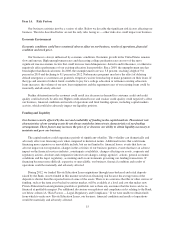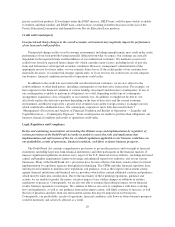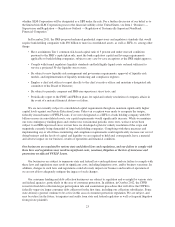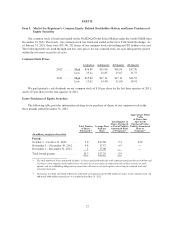Sallie Mae 2012 Annual Report Download - page 20
Download and view the complete annual report
Please find page 20 of the 2012 Sallie Mae annual report below. You can navigate through the pages in the report by either clicking on the pages listed below, or by using the keyword search tool below to find specific information within the annual report.Federal funding constraints and spending policy changes triggered by associated federal spending deadlines
may result in disruption of federal payments for services we provide to the government, which could materially
and adversely affect our business strategy or future business prospects.
We receive payments from the federal government on our FFELP Loan portfolio and for other services we
provide to them, including servicing Direct Loans, default aversion and contingency collections. Funding to pay
for these services may be affected by various factors, including the following:
• Debt Limit: The federal government is expected to reach the statutory borrowing limit by the end of the
first half of 2013 and, once the limit is reached, the federal government will not be able to borrow to meet
its payment obligations.
• 2013 Appropriations: Congress and the Administration must address the expiration at the end of March
2013 of funding for federal government operations.
• Sequestration: In August 2011, Congress passed the Budget Control Act of 2011, which committed the
federal government to significantly reduce the federal deficit over ten years by $1 trillion relative to the
fiscal year 2012 Administration budget submission. Under this Act, as amended, substantial automatic
spending cuts, known as “sequestration,” are scheduled to be implemented on March 1, 2013.
• President’s budget: The President’s fiscal 2014 budget is expected to be released in March 2013. Previous
budgets have included a number of education lending-related initiatives, including proposed reductions in
payments by ED to service providers assisting students with the rehabilitation of defaulted FFELP loans.
If proposals such as these are enacted, they could be detrimental to our business.
It is possible that the Administration and Congress could engage in a prolonged debate linking the federal
deficit, debt ceiling and other budget issues resulting in a similar debate that occurred around the Budget Control
Act of 2011. If U.S. lawmakers now or in the future fail to reach agreement on these issues, the federal
government could stop or delay payment on its obligations, including those on services we provide. We cannot
predict how or what programs will be impacted by any actions that Congress or the federal government may
take. Further, legislation to address the federal deficit and spending could include proposals that would adversely
affect our FFELP and Direct Loan-related servicing businesses. A protracted reduction, suspension or
cancellation of the demand for the services we provide, or proposed changes to the terms or pricing of services
provided under existing contracts we have with the federal government, could have a material adverse effect on
our revenues, cash flows, profitability and business outlook, and, as a result, could materially adversely affect our
business, financial condition and results of operations.
We continue to undertake numerous cost-cutting initiatives to realign and restructure our business in light of
significant legislative changes in the past several years and the amortization of the FFELP Loan portfolios we
service. Our business, results of operations and financial condition could be adversely affected if we do not
effectively align our cost structure with our current business operations, regulatory compliance obligations
and future business prospects.
In response to significant legislative changes in the past several years, including the end of FFELP, we have
undertaken and continue to undertake cost-cutting initiatives, including workforce reductions, servicing center
closures, restructuring and transfers of business functions to new locations, enhancements to our web-based
customer services, adoption of new procurement strategies and investments in operational efficiencies. Our
business and financial condition could be adversely affected by these cost-cutting initiatives if cost reductions
taken are so dramatic as to cause disruptions in our business, reductions in the quality of the services we provide
or cause us to fail to comply with applicable regulatory standards. We may be unable to successfully execute on
certain growth and other business strategies or achieve certain business goals or objectives if cost reductions are
too dramatic. Alternatively, we may not be able to achieve our desired cost savings. In either case our business,
results of operations and financial condition could be adversely affected.
18
























